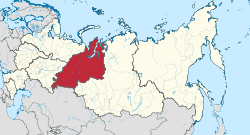Ural Federal District
Coordinates: 56°50′N 60°35′E / 56.833°N 60.583°E
| Ural Federal District Уральский федеральный округ | |
|---|---|
| Federal district of Russia | |
 | |
| Country |
|
| Established | May 18, 2000 |
| administrative center | Yekaterinburg |
| Government | |
| • Presidential Envoy | Igor Kholmanskikh |
| Area | |
| • Total | 1,788,900 km2 (690,700 sq mi) |
| Area rank | 3rd |
| Population (2010) | |
| • Total | 12,080,526[1] |
| • Rank | 6th |
| • Urban | 79.9%[1] |
| • Rural | 20.1%[1] |
| Federal subjects | 6 contained |
| Economic regions | 2 contained |
| Website | www.uralfo.ru |
Ural Federal District (Russian: Ура́льский федера́льный о́круг, Uralsky federalny okrug) is one of the eight federal districts of Russia. Its population was 12,080,523 (79.9% urban) according to the 2010 Census.[1]
The district was established on May 13, 2000 by a decree of the President of Russia.[2] The district is mostly located in the Ural geographical region, but also includes minor parts of the Volga Region. It is located at the border of the European and Asian parts of Russia,[3] and its extent is different from that of the Ural economic region. The administrative center of the district is the city of Yekaterinburg.
The district contributes 18% to Russia's Gross Regional Product, although its population is only 8.5% of the Russian total.[4]
General information and statistics
The district covers an area of 1,788,900 square kilometers (690,700 sq mi), about 10% of Russia. According to the 2010 Census, the district had a population of 12,080,526,[1] of whom 82.74% were Russians (10,237,992 people), 5.14% Tatars (636,454), 2.87% Ukrainians (355,087) and 2.15% Bashkirs (265,586). The remainder comprises various ethnicities of the former Soviet Union. Urban population constituted 79.9%.[1]
In 2006, the district provided 90% of Russian natural gas production, 68% of oil and 42% of metal products. Industrial production per capita in the district is about 2.5 times higher than the average value throughout Russia. The district provides about 42% of Russian tax incomes, mostly from industry. Its major branches are fuel mining and production (53%), metallurgy (24%) and metal processing and engineering (8.8%). The latter two are especially developed in Chelyabinsk and Sverdlovsk Oblast which, between them, constitute 83% of Russian metallurgy and 73% of metal processing and engineering. Whereas fuel and mineral mining has been providing a nearly constant outcome between 1990 and 2006, metal processing and engineering are declining, despite the fact that they employ up to 30% of industry workers of the district. Local ore processing plants can provide only 20% of required copper, 28% chromium, 35% iron and 17% coal, and many of these resources are nearly exhausted. Meanwhile, the average distance to import them to the Ural is 2,500 km.[5]
The district is governed by the Presidential Envoy, and individual envoys are assigned by the President of Russia to all the Oblasts of the district. Pyotr Latyshev was envoy to the Urals Federal District until his death on December 2, 2008. Nikolay Vinnichenko succeeded him on this post on December 8, 2008.[6] On September 6, 2011 Vinnichenko was appointed the envoy to the Northwestern Federal District, and Yevgeny Kuyvashev became the Presidential Envoy in the Urals Federal District.[7] On May 18, 2012 Vladimir Putin offered the tenure to Igor Kholmanskikh, an engineer without any previous political experience, and Kholmanskikh accepted the offer.[8]
Sub-divisions
.svg.png) | |||
|---|---|---|---|
| # | Flag | Federal subject | Administrative center |
| 1 | |
Kurgan Oblast | Kurgan |
| 2 | |
Sverdlovsk Oblast | Yekaterinburg |
| 3 | |
Tyumen Oblast | Tyumen |
| 4 | |
Khanty-Mansi Autonomous Okrug (Yugra) | Khanty-Mansiysk |
| 5 | |
Chelyabinsk Oblast | Chelyabinsk |
| 6 | |
Yamalo-Nenets Autonomous Okrug | Salekhard |
Source for names of the 6 areas of the Urals: [9] (note - source refers to 'regions' rather than Okrugs or Oblasts)
References
- ↑ 1.0 1.1 1.2 1.3 1.4 1.5 "Всероссийская перепись населения 2010 года. Том 1" [2010 All-Russian Population Census, vol. 1]. Всероссийская перепись населения 2010 года (2010 All-Russia Population Census) (in Russian). Federal State Statistics Service. 2011. Retrieved June 29, 2012.
- ↑ "Указ Президента РФ от 13 мая 2000 г. N 849 "О полномочном представителе Президента Российской Федерации в федеральном округе" (Decree #849 by the President of Russia of May 13, 2000)" (in Russian).
- ↑ http://www.smsr-senclub.ru/en/region/index.php?SECTION_ID=350
- ↑ "5 Ural Federal District: The Backbone of the Nation’s Economy". Russia’s Regions: Goals, Challenges, Achievements. National Human Development Report. UNDP. 2006/07. p. 68. Retrieved 3 December 2013.
- ↑ "Екатеринбург, 02 Декабря 2006" (in Russian). Official site of the Ural Federal District.
- ↑ "Vinnichenko for Urals Federal District" (in Russian). interfax.ru.
- ↑ "О назначении полпредов Президента в ряде федеральных округов" (in Russian). Администрация Президента РФ. Retrieved 20 May 2012.
- ↑ "Предложение президента для Игоря Холманских стало неожиданностью". Vesti.ru (Russian). May 18, 2012. Retrieved May 20, 2012.
- ↑ "Ural region". Corporation of Development. Retrieved 26 January 2014.
| ||||||||||||||||||||||||||||||||||||